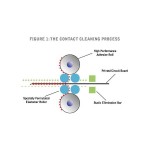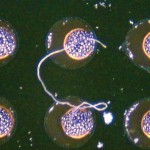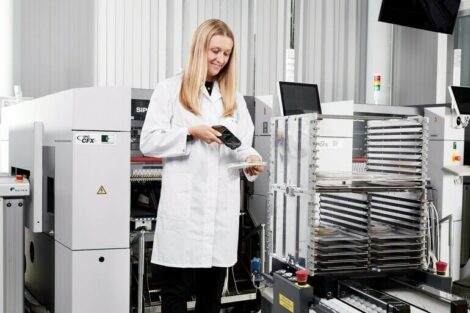Too many European electronics manufacturers are still not aware of the impact contamination is making on their productivity and profitability. Even moderate levels of contamination can lead to downtime, wastage and expensive rework. Every manufacturer is striving for zero defects and 100 % uptime and eliminating contamination from production is a prime element in achieving this. This article will examine the key sources of contamination and how it can be monitored and controlled.
A key factor has been the changing nature of PCBs and electronics production processes themselves. Track and gap widths have become smaller and the number of layers has increased. This means that the potential for very small particles (down to one micron) to disrupt production has become greater. In addition, there has been a move towards the use of more environmentally friendly materials in electronics production. This has affected melting points and solder flow characteristics making the materials stickier and therefore more prone to contamination. Furthermore, copper has a tendency to dissolve into tin-rich lead-free solder alloy which can happen during dipping, wave soldering and rework processes.
Sources and audits
With the possible exception of fine-line circuitry PCBs are rarely assembled in a sterile clean room environment. Therefore there is ample opportunity for contaminants to enter the production process. It is estimated that 80 % of these contaminants into a “clean area” by people and products, 15 % is generated by the products themselves and 5 % is created by the room and filtration system. A detailed contamination audit can be conducted in the production facility to identify the type and source of contamination. Audits using air sampling monitors can only tell you the number of airborne particles in a sample. It does not identify the type of particle nor does it collect particles which are too heavy to be airborne.
A special contamination audit technique has been developed which overcomes these drawbacks. It uses a hand-held elastomer roller to collect contamination samples from any surface in a production facility. The particles are transferred on to a special adhesive pad where the particles can be easily identified and therefore the correct form of remedial action can be taken. From the results of the audit two types of contamination matrix can be constructed. The first is a Contamination Matrix for each department where each result is logged and analysis of the type of contamination is presented. This matrix should make it immediately clear where housekeeping procedures or manufacturing protocols need to be changed or modified. The second type of matrix is a Summary Matrix which covers the whole production facility and lists the departments with their total contamination levels recorded. This matrix is particularly useful as it shows the flow of contamination through the plant.
The matrices can be colour-coded to make them easier to interpret and they highlight the main areas where there is a high risk to production yields and appropriate action can be taken to reduce the contamination levels. After action has been taken to reduce contamination the audit should be repeated in that area to measure the change which has taken place. Changes in process yield should be monitored at the same time. The revised matrix can be overlaid on the original one to show what improvements have been made.
Audit methodology
A contamination audit investigates both the air quality and the type and concentration of surface contamination within the area to be audited. The second objective of the audit is to highlight the sources of the contamination through detailed analysis of the samples and observation of the production processes. The following points should be noted:
- There are two types of process from a contamination viewpoint: First, those which generate contamination as a fundamental part of the process such as drilling or wet processing. Second, those which are sensitive to contamination like solder paste printing, resist application and exposure.
- Plans should be prepared for every area to be audited showing the layout of all the equipment in the room and the position of all doors.
- Any other points where material or product comes into the production area should be noted.
- A corner of the plan should be reserved for notes to record what type of clothing the operators are wearing and any other relevant information.
- The plans will be used to record exactly where samples are taken so that the exercise can be repeated under controlled conditions.
- A device called a tyndleometer is used to assess air quality in a production environment. Sampling is very rapid so that real-time analysis of the samples can be undertaken. The position of where the samples were taken is marked on the department plan.
- Surface contamination is collected using a special hand-held roller which is passed over the surface to be tested. The particles collected are then transferred on to an adhesive pad with a grid pattern on it. The sample is transferred to a release sheet which has details of the exact location of the sample.
- Sample analysis is carried out using a microscope with a variable magnification of up to 60x to examine each square in the sample grid. The type and number of each type of particle should be recorded in the department contamination matrix.
- If there are any unusual or unidentifiable particles in the sample, colour photographs should be taken for further reference and investigation.
Sources of contamination
Key sources of contamination within the production environment include:
- 1. Human hair – a person loses, on average, 50 hairs per day.
- 2. Lint – although specialist cleaning cloths used in the production area are supposedly “lint free” they can still snag when used for wiping pad areas and stencils, creating loose fibres which can enter the production process.
- 3. Clothing fibres – fibres from operator’s clothing are a frequent source of contamination.
- 4. Dust – the main source of dust is shed human skin. On average a person breathes 700,000 skin flakes per day and discards one layer of skin every day.
- 5. Production plant – particles from ceilings, floors, shelving as well as packaging materials can enter the production line.
- 6. Epoxy dust – during the manufacture of bare boards every effort is made to remove any contaminants. However, after routing only the top surface can be cleaned leaving loose dust on the edges.
- 7. Glass splinters – PCBs can produce loose glass from snap outs or routing.
- 8. Solder paste – loose solder paste can remain on misprinted boards which are wiped “clean” and sent back through the production line.
- 9. Solder resist – this can flake off leading to contamination.
- 10. Packaging materials – boards often come individually wrapped in paper. When removed some paper fragments can cling to the board due to static.
Preventing static
Contamination is attracted to PCBs by static charge. By their very nature PCBs are insulators so will generate a static charge whenever being handled or removed from packaging. It is essential therefore that static is eliminated from the production process. This can be achieved by installing static neutralization equipment after the boards have been cleaned and before they are populated to prevent recontamination.
Common problems
The most common problems caused by contamination are:
- Contamination in the solder paste can cause craters in the solder during the reflow process.
- Particles can block stencil holes leading to an incomplete print.
- Contamination can cause tombstoning whereby the chip component stands on end with one end not connected.
- Fibres from cloths used to clean stencils can become trapped between pads leading to short-circuits.
- Contamination can also lead to unreliable solder joints and poor solder wetting.
Solutions
What can be done to combat contamination? The first thing to do is to ensure high standards of cleanliness are enforced throughout the production site. There should be a scheduled cleaning routine which should also include the thorough cleaning of the production equipment as debris inside the production equipment can contaminate the boards. However, it is vital that the PCBs are scrupulously precleaned before they enter the production process. Many manufacturers attempt to do this with vacuum and blower systems which can remove some of the contamination but not all. A more effective solution is to use specialist contact cleaning equipment. This equipment incorporates a series of special elastomer rollers which make contact with the substrate lifting off loose particles down to one micron in size. These particles are then transferred to a pre-sheeted adhesive roll for examination and disposal. It is a useful exercise to analyse the type and number of particles captured, using a microscope, as this can help you put in place measures to stop contamination entering the production environment in the first place. Contact cleaning equipment should also have static neutralization facilities built-in to prevent the boards from being re-contaminated before they enter the next phase of the production process.
Contact cleaning equipment varies enormously in terms of quality so should be chosen carefully. For example, the chemical composition of the elastomer rollers is important. Buy an inferior roller and it will leave some contamination behind leading to more rejected boards, decreased yields and increased downtime. However, employing effective contact cleaning equipment has been shown to reduce reject rates by over 50 % and increase yields in excess of 90 %.
Boards which are precleaned and have undergone static neutralization offer a better surface for printing, improve solder joint integrity and provides better stencil to board gasketing. This means that rework is greatly reduced and the incidence of wasted boards is sharply decreased.
In summary contamination can have a significant impact on production yields, rework, wastage and downtime. By proper auditing and analysis of contamination in the production facility it is possible to implement effective measures which will negate the effects of contamination.
SMT, booth 8-300, 7-521
EPP Europe
zusammenfassung
Zusammenfassend kann festgehalten werden, dass Kontaminationen oder Verunreinigungen erhebliche Auswirkungen auf den Produktionsertrag, das Rework beziehungsweise die Nacharbeit, auf Ausschuss und auf Stillstandszeiten haben. Durch sachgemäße Prüfung und Analyse der Verunreinigungen in der Produktionsstätte ist es möglich, wirksame Maßnahmen anzuwenden, die den Einfluss von Kontamination zunichte machen.
En résumé, on retiendra que la contamination et les impuretés ont des effets considérables sur le rendement de production, le réusinage ou le post-usinage, les rebuts et les arrêts de production. Un contrôle et une analyse corrects des impuretés présentes dans les locaux de production permettent d’appliquer des mesures efficaces afin d’annuler les effets de la contamination.
Riassumendo si può affermare che le contaminazioni o le impurità hanno forti ripercussioni sull’utile della produzione, il Rework o la lavorazione successiva, sugli scarti e i tempi di sosta. Mediante il controllo appropriato e l’analisi delle impurità negli stabilimenti di produzione è possibile adottare misure efficaci a ad eliminare della l’effetto della contaminazione.
Share:












